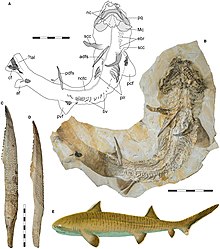
Summary
Asteracanthus (from Greek: ἀστήρ aster, 'star' and Greek: ἄκανθα akantha, 'spine')[1] is an extinct genus of hybodont, known from the Middle Jurassic (Bathonian) to the Early Cretaceous (Valanginian).[2]
| Asteracanthus Temporal range:
| |
|---|---|

| |
| Complete skeleton and restoration of Asteracanthus ornatissimus from the Solnhofen Limestone | |
| Scientific classification | |
| Domain: | Eukaryota |
| Kingdom: | Animalia |
| Phylum: | Chordata |
| Class: | Chondrichthyes |
| Subclass: | Elasmobranchii |
| Order: | †Hybodontiformes |
| Family: | †Hybodontidae |
| Genus: | †Asteracanthus Agassiz, 1837 |
| Type species | |
| Asteracanthus ornatissimus Agassiz, 1837
| |
Description edit
Asteracanthus was among the largest known hybodontiforms, reaching a length of 2–3 metres (6.6–9.8 ft). The dentition of Astercanthus is high crowned and multicusped. The low-rounded teeth previously attributed to the genus actually belong to Strophodus. Like Strophodus, the fin spines are covered in tubercles, rather than the ribbing typical of other hybodont fin spines.[2]
Fossil records edit
The genus as currently circumscribed dates from the Middle Jurassic (Bathonian) to Early Cretaceous (Valanginian) of Europe, including Germany, Switzerland, England and France. A complete skeleton was described in 2021 from the Late Jurassic (Tithonian) aged Solnhofen Limestone. Previously considered synonymous, the genus Strophodus (Middle Triassic-Late Cretaceous) is now considered distinct, with the teeth of Asteracanthus having more in common with Hybodus and Egertonodus.[2]
Ecology edit
The genus seems to have been adapted for open marine conditions and likely had an epibenthic habit. It was likely a slow swimmer. The teeth are suggested to have been adapted for grasping, with the teeth at the sides of the mouth serving a crushing function. Asteracanthus was probably adapted for feeding on a wide range of prey, ranging from moderately hard shelled to soft-bodied. Teeth of Asteracanthus found with the remains of marine reptiles suggest that it may have also engaged in scavenging.[2]
Taxonomy edit
Many of the species previously assigned to this genus are now placed in Strophodus, with a 2021 study considering Asteracanthus ornatissimus the only certain species in the genus. The study considered the genus incertae sedis within Hybodontiformes.[2]
References edit
- ^ Roberts, George (1839). An etymological and explanatory dictionary of the terms and language of geology. London: Longman, Orme, Brown, Green, & Longmans. p. 12. Retrieved 12 February 2024.
- ^ a b c d e Stumpf, Sebastian; López-Romero, Faviel A.; Kindlimann, René; Lacombat, Frederic; Pohl, Burkhard; Kriwet, Jürgen (2021-01-13). Cavin, Lionel (ed.). "A unique hybodontiform skeleton provides novel insights into Mesozoic chondrichthyan life". Papers in Palaeontology. 7 (3): 1479–1505. Bibcode:2021PPal....7.1479S. doi:10.1002/spp2.1350. ISSN 2056-2799.
Further reading edit
- L. Agassiz. 1837. Recherches Sur Les Poissons Fossiles. Tome III (livr. 8–9). Imprimérie de Petitpierre, Neuchatel viii-72


